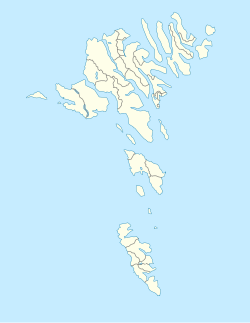Oyri | |
|---|---|
Village | |
 Oyri | |
 Harbor scene | |
| Coordinates: 62°11′26″N6°58′24″W / 62.19056°N 6.97333°W | |
| State | |
| Constituent country | |
| Island | Eysturoy |
| Municipality | Sunda |
| Population (September 2025) [1] | |
• Total | 181 |
| Time zone | GMT |
| • Summer (DST) | UTC+1 (EST) |
| Postal code | 450 |
| Climate | Cfc |
Oyri is a village on the central west coast of the Faroese island Eysturoy in the Sunda municipality.
Contents
The 2005 population was 142. Its postal code is FO 450. The village is south of the Eysturoy-to-Streymoy bridge, and is home to a large fish processing plant. [2]

